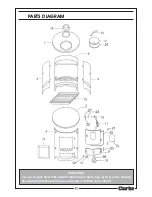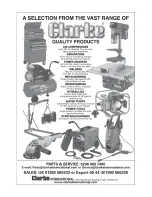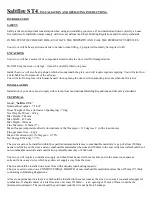
17
quantity of dry kindling wood. Place a small quantity of solid fuel on top.
3. Light the newspaper or firelighters using a long taper and close the door.
4. When the fire is burning strongly, add further fuel.
5. When the stove is hot, reduce the opening of the air controls.
6. The burn rate can be reduced by partially closing the air controls or
damper.
REFUELLING
1. Always open the door slowly to avoid a sudden rush of intake air and
smoke escaping into the room and add fuel.
2. Open the air controls and leave open for a few minutes to allow the
gasses in the wood to burn before closing the air controls.
•
The rate of refuelling and heat available are dependant upon individual
requirements based upon the user’s experience. When re-loading, it is
normally necessary to burn the stove fast initially, to drive off any gasses
and moisture, before closing the air vents to control the burn rate.
•
Ensure the doors are kept closed to contain fumes except when lighting
up, re-fuelling or removing ash.
•
It is not recommended to leave the stove alight at night or to continue
using the stove in mild weather which gives poor combustion leading to a
greater buildup of soot.
•
If overnight burning is required, can best be achieved by first driving off
any gasses or moisture as usual, following a full charge of fuel and then
closing the air vents fully. Experience will indicate the optimum setting.
However, by reducing the burn rate to such a level that the fire is still
burning the following day, the burning process creates heavy, tarry
chemicals which will become deposited on the inside of the flue or
chimney. This is an inefficient process which greatly increases the risk of a
chimney fire and makes it necessary to sweep the chimney more often.
ASH REMOVAL
Keep the stove free from a heavy buildup of ash. The frequency of this is
dependant upon the type and quality of fuel being used. Ash should be
removed before it builds up to the underside of the grate, at which point, the
grate would be burning hot on both sides, shortening its life expectancy.
When disposing of ashes, ensure they have cooled and always place in a
metal container. Be sure to remove the ash when the fire is at its lowest point,
such as first thing in the morning.
The Ash Can Filter is ideal for use in conjunction with the Clarke range of
vacuum cleaners, for collecting hot ash and debris from stoves.
Summary of Contents for BARREL
Page 1: ...USER GUIDE GC0711 Classic Cast Iron Stove BARREL PART NO 6910100 ...
Page 23: ...23 DECLARATION OF CONFORMITY ...
Page 24: ......








































